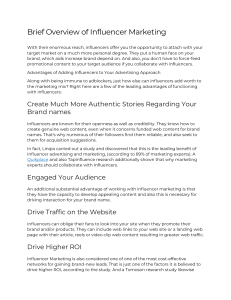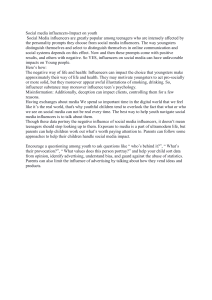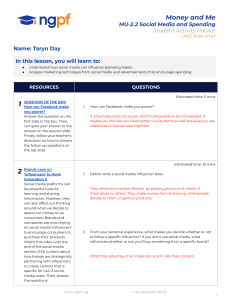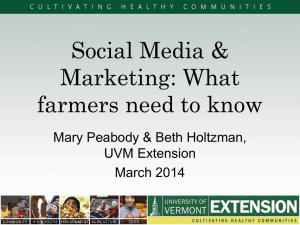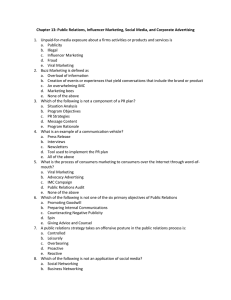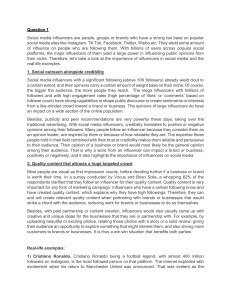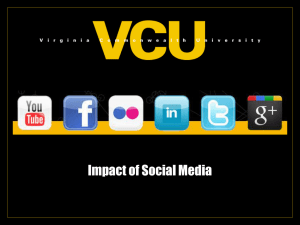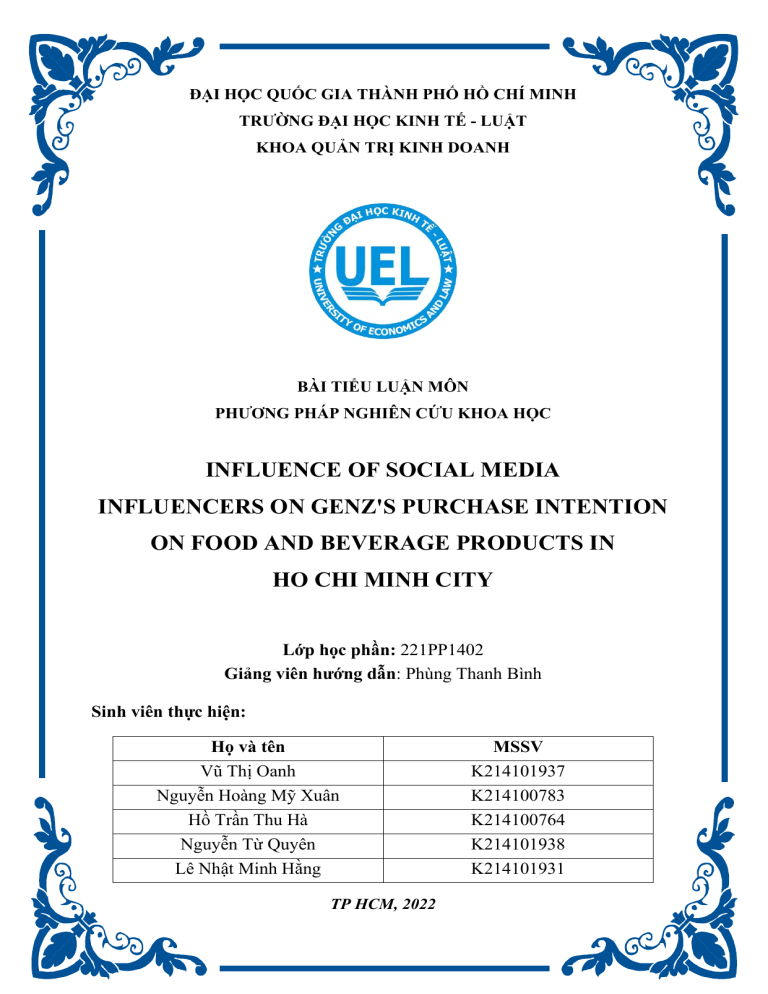
ĐẠI HỌC QUỐC GIA THÀNH PHỐ HỒ CHÍ MINH TRƯỜNG ĐẠI HỌC KINH TẾ - LUẬT KHOA QUẢN TRỊ KINH DOANH BÀI TIỂU LUẬN MÔN PHƯƠNG PHÁP NGHIÊN CỨU KHOA HỌC INFLUENCE OF SOCIAL MEDIA INFLUENCERS ON GENZ'S PURCHASE INTENTION ON FOOD AND BEVERAGE PRODUCTS IN HO CHI MINH CITY Lớp học phần: 221PP1402 Giảng viên hướng dẫn: Phùng Thanh Bình Sinh viên thực hiện: Họ và tên Vũ Thị Oanh Nguyễn Hoàng Mỹ Xuân Hồ Trần Thu Hà Nguyễn Từ Quyên Lê Nhật Minh Hằng TP HCM, 2022 MSSV K214101937 K214100783 K214100764 K214101938 K214101931 TABLE OF CONTENTS ABSTRACT………………………………………………………….3 CHAPTER I: INTRODUCTION ....................................................... 3 1.1. THE REASON FOR CHOOSING THE TOPIC ......................................... 3 1.2. OVERVIEW OF THE RESEARCH SITUATION.. LỖI! THẺ ĐÁNH DẤU KHÔNG ĐƯỢC XÁC ĐỊNH. 1.3. RESEARCH OBJECTIVES .......................................................................... 4 1.3.1. General and Specific objectives ..................................................... 4 1.3.2. Research questions .. Lỗi! Thẻ đánh dấu không được xác định. 1.4. SCOPE OF RESEARCH ................................................................................ 5 1.5. RESEARCH METHODOLOGY .................................................................. 5 1.6. MEANINGS OF THE RESEARCH............LỖI! THẺ ĐÁNH DẤU KHÔNG ĐƯỢC XÁC ĐỊNH. 1.7. STRUCTURE OF THE STUDY .................................................................... 6 CHAPTER II: LITERATURE REVIEW ... LỖI! THẺ ĐÁNH DẤU KHÔNG ĐƯỢC XÁC ĐỊNH. 2.1. INFLUENCER MARKETING LỖI! THẺ ĐÁNH DẤU KHÔNG ĐƯỢC XÁC ĐỊNH. 2.1.1. Influencer ....... Lỗi! Thẻ đánh dấu không được xác định. 2.1.2. Influencer marketing Lỗi! Thẻ đánh dấu không được xác định. 2.1.3. Vietnam's F&B industry .................................................................. 9 2.2. CONCEPTUAL MODEL AND HYPOTHESIS DEVELOPMENT .......... 9 CHAPTER III: METHODOLOGY ............ LỖI! THẺ ĐÁNH DẤU KHÔNG ĐƯỢC XÁC ĐỊNH. 3.1. MEASURES .................. LỖI! THẺ ĐÁNH DẤU KHÔNG ĐƯỢC XÁC ĐỊNH. 3.2. QUANTITATIVE RESEARCH DESIGN ..LỖI! THẺ ĐÁNH DẤU KHÔNG ĐƯỢC XÁC ĐỊNH. CHAPTER IV: CONCLUSIONS AND IMPLICATIONS .......LỖI! THẺ ĐÁNH DẤU KHÔNG ĐƯỢC XÁC ĐỊNH. 2 3 ABSTRACT In today's media landscape, the young generation, especially Genz prefer using social media channels (social networks) like Facebook, Instagram, Tiktok over traditional communication channels, such as television stations, newspapers to exchange information and build relationships (Hair, Clark and Shapiro, 2010). According to a survey the research team conducted, the impact of Influencer Marketing on GenZ in Ho Chi Minh City on the FnB industry has reached 65%. Several studies have also demonstrated how easily social media influencers can affect people's eating decisions, especially young people and adolescents. This paper aims to analyse the factors of influencers that affect Gen Z consumers' decision to purchase food and beverage products in Ho Chi Minh City. Then, apply and offer some recommendations for firms in the F&B sector in Vietnam to increase the efficiency of brand-promotion efforts utilizing social media influencers. I. INTRODUCTION 1.1. The reason for choosing the topic Vietnam is making economic strides and has accomplished certain goals. As people's living circumstances rise, eating well and wearing beautiful clothes has progressively replaced eating well and wearing warm clothes for quite a period of years. With a population of more than 97 million people, the majority of whom are young, this is a very promising market for the food and beverage (FnB) industry to quickly establish itself. FnB refers to the food and beverage sector. As a result, we may conclude that the FnB service industry is the business of food, beverage, and food goods, as well as the business of the dividends that comprise the brand. In the past few years, social media influencers have had a significant and overwhelming impact on the marketing of products, services, and corporate brands, especially in the FnB industry. Brands and their relationships with customers changed because of this major impact. Since every business, regardless of size, specialty, or category, finds social media to be a valuable medium for reaching out to clients and potential customers with the least number of problems, the influence will not fade within the next year. 4 1.2. Overview of the research situation In today's world, traditional marketing channels become less important because of social media presence in more ways than one. While all traditional media and advertising options are expensive and usually out of reach for small businesses, social media has emerged as a potential low-cost and highly successful option for them. FnB businesses, which are now one of market leaders, may significantly reduce their advertising and marketing expenditures by utilizing social networking platforms. According to a Vietnam Briefing, accounting for 35% of monthly spending and 15% of the country's GDP for the majority share of Vietnamese spending expenditure by F&B accounts; this figure is likely to rise in the future years. After the Covid-19 epidemic, the F&B business had been rapidly expanding, owing to a confluence of favorable trends such as population expansion, rising household incomes, and changes in consumer behavior, especially Gen Z, through social media influencers. As shown by research examining Gen Z behavior, influencers have the capacity to impact their purchasing patterns. According to research by Kantar M.Brown (2020), 44% of GenZ-ers have made a purchasing choice based on the suggestion of an influencer. In another Survey Monkey study, more than half of Gen Z (58%) have bought based on a suggestion from a social media influencer or content creator. 1.3. Research objectives 1.3.1. General and Specific objectives Instead of clear sustainability aims, social media has economic interests. However, because they are all representatives of the firm, it is in their best interests to maintain its corporate sustainability. Several specialist papers investigate, to the best of our knowledge, the possibly diverse roles performed by various influencers in influencing social network users' participation with marketed items when it comes to ensuring company sustainability. The purpose of this research is to satisfy current needs: 5 (1) Understand and explain the factors of social media influencers that affect GenZ’s purchase intention on FnB and identify distinguishing characteristics of influencers on social media that may be used to their ranking. (2) Evaluate and compare those factors affecting GenZ’s purchase intention on food. (3) Investigate the potential of social media influencers marketing. Propose solutions and make suggestions for the firms. 1.3.2. Research questions We conduct research on this topic to answer these questions: (1) What exactly is the relation between Generation Z and Influencers? (2) What are the factors of social media influencers that influence GenZ’s purchase intention on food and beverage products? (3) How are these factors influencing GenZ’s purchase intention on food and beverage products? 1.4. Scope of research - Research objective: The social media influencers' characteristics affect Gen Z's purchase intention in the Vietnamese FnB market. - Survey objective: GenZ aging 10 to 25, no career limitations. - Graphic area: Ho Chi Minh City. - Time: The research is carried out from October 10, 2021, to November 21, 2022. 1.5. Research Methodology The study combines two methods: qualitative research and quantitative research. a) Qualitative research: Gathering data and customer opinions through customer surveys and interviews about the effects of online influencers towards their purchase intention through FnB in Ho Chi Minh City. 6 b) Quantitative research: Collecting, processing information, and analyzing data for the research through questionnaires that have been designed and built by taking surveys on social networks using Google Forms, For the variables of the scale, to assess the level of consumer agreement, the questionnaire is designed with the Likert scale, 5 levels with 1 being “strongly disagree” to 5 being “strongly agree” with 300 questionnaires distributed. After collecting the required number of samples, the data is processed by SPSS software to test the scale through Cronbach's Alpha reliability coefficient and EFA exploratory factor analysis. Then the factors extracted from the data set will be put into correlation analysis and regression analysis to evaluate the proposed model and test the hypotheses. 1.6. Meanings of the research This study aims to determine the subjective and objective factors of influencers affecting consumption behavior, specifically the purchase intention of Gen Z consumers in Ho Chi Minh City through the results of evaluation and recognition. From there, we propose solutions to promote the positive factors and at the same time overcome the negative effects, suggest ways for Genz customers to effectively purchase FnB products and finally make recommendations to businesses in the FnB industry that have orientations and changes when using Influencer Marketing to boost business efficiency. 1.7. Structure of the study This research has four chapters: - Chapter 1: Introduction. This part will present the reason for choosing the topic, research objectives, overview of the research situation, research methodology, object, and scope of the research, meaning of the topic, and structure of the study. - Chapter 2: Literature reviews. In this chapter, the research team will present the basic theories used to study the hypothesis to draw the research model. - Chapter 3: Research Methodology. This chapter will describe the research process and methods in detail: quantitative research, qualitative research, primary data, data analysis process, and data analysis methods. Thereby assessing the reliability of the research results. 7 - Chapter 4: Conclusions and Implications. In this part, the research team will present in detail and provide specific research results with tables of processed data. Then, based on this result to interpret and draw conclusions. II. LITERATURE REVIEW 2.1. Influencer marketing 2.1.1 Influencer There appears to be a lack of concurrence about defining an influencer. According to Keller & Berry (2003), an influencer is described as a person who has an active mind and creates activities that impact various networks. To put it differently, an influencer is not required to be famous but whoever influences their own communities. In the marketer world, the influencer of social media is defined in the definition of Duncan & Hayes (2008) that people mostly agree with: An influencer is a third party who has a considerable impact on a customer's purchase choice. These influencers vary in different kinds and influence in different levels. 2.1.2. Influencer marketing "Influencer marketing" is the practice of leveraging individuals with influence towards potential consumers, orienting marketing campaigns around these people to promote a business message and products to the global market via social networking platforms and partnerships with opinion leaders (Bijen, 2017; Levin, 2019). Thus, influencer marketing is remarkably effective. This marketing form works in tandem with the creation of messages delivered by influencers to intensify brand awareness extent toward consumer segmentations in both cognition and emotion. Although celebrities have always been used in marketing efforts to capitalize on their celebrity in order to promote enterprises (Cheah, Ting, Cham, & Memon, 2019), influencers on social media are a distinct and more modern use of this strategy. Influencers and celebs are conceptually separate because influencers "natively" create their major activity on social media, whereas celebrities are known for their non-social media undertakings (Dhanesh & Duthler, 2019). (like sports, music, etc). 2021 (Tafesse and Wood) (Schouten et al., 2019). 8 The reputation of influencers is thus solely based on the content they give and their social media involvement, which is often done in collaboration with their fans (Hu et al., 2020, Schouten et al., 2019). As a type of virtual friend, they typically target a more narrow audience with whom they have like interests. Because they appear to be more in touch with their potential audiences, influencers frequently appear more trustworthy or reputable than traditional superstars (Lou & Yuan, 2019; Sokolova & Kefi, 2019). The fact that social media influencers become thought leaders or authority among their followers in their specialized domains reveals their importance and potential consequences (Rahman, Saleem, Akhtar, Ali, & Khan, 2014). As a result, when making purchasing decisions, followers commonly seek out or depend on their advise (Casaló et al., 2020; Schaefer, 2012). According to some past research (Choi and Rifon, 2012; Casaló et al., 2020), the resemblance between an influencer's appearance and followers' interests is a potential motivator. De Veirman, Cauberghe, and Hudders (2017), Erz, Marder, and Osadchaya (2018), as well as other influencer studies have shown impacts related to their followers, hashtags usage, or activity metrics (Arora, Bansal, Kandpal, Aswani, & Dwivedi, 2019). Another area of research investigates the consequences of certain communication characteristics, such as how influencers expose the commercial origin of advice (Boerman, 2020, De Veirman and Hudders, 2020, Jin and Muqaddam, 2019, Sokolova and Kefi, 2019). Control the product-influencer fit and indicate that a great match leads to buyers having more positive feelings about the product and lowers their perceptions that the promo is advertisement (Kim and Kim, 2020). Instead of recommendations from the brand or company itself, customers are more likely to believe those from third sources. This is especially true if you consider it in a personal context: it's difficult to trust someone you don't know at a coffee shop to start a conversation and then talk about themselves. entice you to join their social network. But if you and the person who shared those things were friends, you would be more likely to trust it. Influencers, who connect companies with their target audience, are buddies with similar interests. Influencers provide their followers resources for knowledge and creativity. The best results for influencer marketing efforts are achieved when there is a high degree of 9 congruence between the customer and the product. This leads to greater positive sentiments of the item as well as improved purchase and referral intentions. 2.1.3. Vietnam's F&B industry: The food service sector in Vietnam is expected to grow at an 8.50 percent CAGR between 2022 and 2027. A significant proportion of monthly earnings is spent on eating out, indicating that the sector is thriving. The country now has 550,000 F&B outlets, including 430,000 conventional meals and 82,000 chain restaurants. From 2022 to 2027, Vietnam's food service sector is predicted to grow at an 8.50 percent CAGR. A third of monthly income goes on eating out, showing that the industry is rapidly expanding. There are presently 550,000 food and beverage establishments in the country, including 82,000 fast-food restaurants and 430,000 typical restaurants Social influence comprises endorsements and promotion from celebrities, key opinion leaders (KOLs), and influencers as well as suggestions from their social network. They can become devoted clients or occasional guests depending on whether they receive satisfactory services and rates that correspond to their impressions and the caliber of the meal. The social networking sites that consumers use for social media influencers may be seen in the survey analysis's findings on the traits of consumers' practices of doing so in Vietnam. The most popular social media platforms for following influencers are Facebook (93.5%), Instagram (87.1%), and YouTube (75.3%). The majority of consumers (94.6%) seek advice from influencers in the culinary industry who are qualified, skilled, and informed, such chefs, blogs,... The majority of customers said they want to speak with influencers because they offer a lot of relevant information (63.5%), expertise and skills (56.8%), and there are lots of appealing product photographs (50%). All of the survey participants had considered and purchased the influential food items listed in the article. 48.4% of participants sporadically view influencer postings, and 37.6% frequently do so. When consumers see social media influencers post about food and drink goods, they choose videos with 73.6% of the vote, followed by images with 66.7%. 2.2. Conceptual model and hypothesis development Expertise 10 Expertise level is defined as the extent to which the influencer is perceived as having knowledge or skill in a particular field (Ratchel et al., 2014). While expertise is highlighted to have a positive impact on both attitude and purchase intention (Till and Busler, 2000). Silvera and Austad (2004) highlighted that target groups' purchase intention is at a higher level when the influencers are more reliable since his/her higher expertise, trustworthiness and attractiveness. When influencers post about particular products or promote brands on social media platforms using their own expertise, the message of the products or brands can be seen as more trustworthy to their followers rather than sponsored commercials (Kassoway, 2015). As a result, the following hypothesis is proposed: H1: The expertise of the influencer has a positive effect on consumers’ purchase intention. Influencer Credibility Influencers are considered as more credible and trustworthy than typical celebrities, and this has a substantial influence on the purchase intentions of their followers. Sen & Lerman (2007) back up Deatara et al. (2019) findings by claiming that highly credible communicators are more convincing than those with poor credibility. Jiang's (2018) study also stated that a credible celebrity has a favorable influence on marketing effectiveness, such as enhancing customers' perceptions toward the brand and purchase intention. Based on this, it is proposed: H2: The influencer credibility has a positive effect on consumers’ purchase intention. Likability Likability is described as the affection of an information receiver for the information source's appearance and character attributes (Kiecker & Cowles 2001; Teng et al., 2014). One of the most significant variables affecting a consumer's attitude is their opinion of an influencer (Li et al., 2014). In current study, likability is defined to be an individual’s tendency to be driven to the communicator’s charm or persona, or his/her level of sociability or approachability (Xiao et al., 2018). Therefore, likability of an influencer is positively shown to increase credibility, consumer attitudes and buying intention (Kumar, 2011). Thus, we extend our hypothesis as follow: 11 H3 = Likeability of the influencer has a positive effect on consumers' purchase intention. Information Quality The quality of information is positively correlated with the reliability of authentication information (Cheung et al., 2012). The informative value of sponsored posts created by influencers positively influences consumers' trust towards those posts, and this ultimately shapes brand perception as well as consumer purchase intention (Arli, 2017; Taylor et al., 2011). Thus, the following hypothesis is projected: H4 = The quality of the influencers' information has a positive effect on consumers' purchase intention. Entertainment Value Entertainment is crucial in forming customers' attitudes and affecting their buy intentions, according to previous research by Mustafi and Hosain (2020). Courtois et al., De Marez, and Verleye (2009) revealed that the major reasons for most consumers to load social media contents are enjoyment and escapism, which are the key indicators of entertainment fulfillment. Organizations may enhance their value from consumers by successfully entertaining them and increasing their perspectives of brands through word-of-mouth and brand trust (Kang, 2005). As a result, an influencer's content having such perceived entertainment value is also likely to shape credibility and purchase intention. Consequently, hypothesis 5 is thus proposed: H5 = The influencer’s entertainment value has a positive effect on consumers' purchase intention. Figure 1: Proposed research model 12 III. METHODOLOGY 3.1. Measures This article uses the quantitative research method by comparing statistics from reputable sites and referencing related documents. The questionnaire is pre-programmed with questions about the variables on a five-point Likert scale ranging from 1 (strongly disagree) to 5 (strongly agree). A total of five measurement indicators were used to measure the cuisine of Genz in this study. Each of them were developed by different authors. Appendix contains the specific scale items for the constructions that were researched and created for this study. Table 1. Measurement Items NO INDICATORS Influencer expertise 1 A social influencer is an expert in the field of cuisine. 13 CODE IE IE1 2 Social media influencers with experience in the food industry. IE2 3 Social media influencers are knowledgeable about the culinary. IE3 4 Social media influencers with qualifications in gastronomy. IE4 5 Social media influencers with enough skills to introduce products in the culinary. IE5 Influencer credibility IC 1 A social media influencer is a trustworthy person. IC1 2 Social media influencers honestly introduce cuisine. IC2 3 Social media influencers have a sincere attitude. IC3 Influencer likability IL 1 Social media influencers are friendly people. IL1 2 Social media influencers have a likable personality. IL2 3 Social media influencers with a warm personality. IL3 4 Social media influencers are easily accessible. IL4 5 I will ask influencers for advice. IL5 6 I want to be friends with social media influencers. IL6 7 Influencers are physically attractive. IL7 8 Influencers have a lot in common with me. IL8 Influencers' quality information IQI 1 Social media influencer reviews are trustworthy. IQI1 2 The argument of the influencer is very convincing. IQI2 3 The influencer's rating, this influencer is trustworthy. IQI3 4 The influencer comments made in this review are consistent with other reviews. IQI4 Influencer’s entertainment value IEV 1 You appreciate interesting reviews. IEV1 2 You appreciate helpful reviews. IEV2 3 You appreciate long strokes that bring a sense of comfort. IEV3 4 You appreciate funny reviews. IEV4 14 Purchase intention PI 1 I became aware of a new food brand/product through a social media influencer I follow. PI1 2 After watching the influencer, I felt more assured about purchasing a stylish product and I now utilize it as advised. PI2 3 I will continue to choose fashion products used by the influencers I follow. PI3 3.2. Quantitative research design Table 2. Proposed Questionnaire PART 1: FILTER QUESTIONS 1 Yes 2 No 2. Are you between the ages of 10 and 25? 1 Yes 1. Are you living in HCM city? 2 No PART 2: SURVEY ISSUES Below are the criteria on the factors of packaging that affect your decision to choose canned products. Please answer the following questions in the form of an assessment of your level of agreement with the statements with the corresponding boxes: 1-Completely disagree; 2- Disagree; 3-Normal; 4- Agree; 5- Totally agree. STATEMENT ASSESSMENT Strongly disagree Disagree Normal Agree Strongly agree 1. Influencer expertise A social influencer is an expert in the field of cuisine. 1 2 3 4 5 Social media influencers with experience in the food industry. 1 2 3 4 5 Social media influencers are knowledgeable about the culinary. 1 2 3 4 5 Social media influencers with qualifications in gastronomy. 1 2 3 4 5 15 Social media influencers with enough skills to introduce products in the culinary. 2. 1 2 3 4 5 Influencer credibility A social media influencer is a trustworthy person. 1 2 3 4 5 Social media influencers honestly introduce cuisine. 1 2 3 4 5 Social media influencers have a sincere attitude. 1 2 3 4 5 3. Influencer likability Social media influencers are friendly people. 1 2 3 4 5 Social media influencers have a likable personality. 1 2 3 4 5 Social media influencers with a warm personality. 1 2 3 4 5 Social media influencers are easily accessible. 1 2 3 4 5 I will ask influencers for advice. 1 2 3 4 5 I want to be friends with social media influencers. 1 2 3 4 5 Influencers are physically attractive. 1 2 3 4 5 Influencers have a lot in common with me. 1 2 3 4 5 4. Influencers' quality information Social media influencer reviews are trustworthy. 1 2 3 4 5 The argument of the influencer is very convincing. 1 2 3 4 5 The influencer's rating, this influencer is trustworthy. 1 2 3 4 5 The influencer comments made in this review are consistent with other reviews. 1 2 3 4 5 5. Influencer’s entertainment value You appreciate interesting reviews. 1 2 3 4 5 You appreciate helpful reviews. 1 2 3 4 5 16 You appreciate long strokes that bring a sense of comfort. 1 2 3 4 5 You appreciate funny reviews. 1 2 3 4 5 6. Purchase intention I became aware of a new food brand/product through a social media influencer I follow. 1 2 3 4 5 After watching the influencer, I felt more assured about purchasing a stylish product and I now utilize it as advised. 1 2 3 4 5 I will continue to choose fashion products used by the influencers I follow. 1 2 3 4 5 IV. CONCLUSION AND IMPLICATIONS Recently, social media are firmly anchored in how consumers change their behaviors to stay current with the latest trends. Thus, this paper contributes to the model that investigates the influence on influencer marketing on social media on purchase intention of consumers toward food and beverages products in HCM City with five components, namely Expertise, Influencer credibility, Likability, Information quality, Entertainment value. Based on research regarding how influencer marketing affects customer purchasing behavior, the authors stress the significant importance of all three factors of influencer's expertise, influencer's likability, influencer's entertainment value all have a positive impact on the intention to purchase food and beverage products at different levels of impact. In which, the influencer's likeability has the strongest impact on the purchase intention, while the expertise factor affects the purchase intention. Finally, the factors in the model have explained the variation of intention to purchase food and beverage products. This study was conducted for FnB businesses when using influencers to promote their products, so it is important for businesses to understand these influencing factors. In addition, this study also helps influencers on social networks to capture customer behavior so that they can learn from experience and create greater influence. According to research results, businesses, communications, and marketers should recognize the influences and consequences of influencers on customer purchasing 17 decisions in order to develop marketing strategies that suit consumer behavior and effectively use influencer marketing. Businesses identify influencers within the FnB industry and focus on individuals with common audiences. Via their Personal Brand (life idea, fashion style, statement), demographic data (gender, age, marital status, field of activity), and content of postings on personal sites, companies can assess how relevant an influencer is to their brand. Besides, businesses in the food and beverage field can select influencers with knowledge and skills in the culinary sector, such as chefs, culinary experts, food stylists, and food reviewers to strengthen the persuasiveness of their marketing campaigns. Businesses should give influencers precise information and understanding about the product while dealing with them so that they can understand it and convey it to readers. When selecting an influential face to represent their brand, businesses should consider this influencer reputation, especially regarding controversies, and negative information. Moreover, if this influencer is advertising many brands at once, he may promote brands with contrasting images, which will cause negative reactions in consumers. Customers will become irritated and believe that the influencer only writes about products because they are paid, which will damage their faith in the influencer. Businesses also need to know whether the influencer can maintain the quality of their posts. Customers will readily trust these influencers if the quality of their content is consistent, created with care, and enthusiastically shared. Simple posts, influencer personal shares, and sponsored pieces ought to be distributed fairly. Consumers would conclude that an influencer has only one goal to generate money if all of their articles are advertisements for brands rather than just offering information that will benefit the industry. Taking advantage of these applications, developing influencer marketing will help reduce more commercial costs than traditional marketing activities, hence maximize company’s profits. The study limitations include we excluded conference papers and theses due to quality concerns that could not be assured and only chose peer-reviewed journal articles and books. As a consequence, it is not possible to generalize the relationships discovered in the research to all types of opinion leaders or social media platforms. The second is that the sample size is not large and the objects of observation are concentrated in Ho Chi 18 Minh City. Therefore, subsequent studies can be extended to the sample size and research space to improve the generalizability of the research model. Therefore, one of the next research directions that the team wants to improve is to be able to go into the field to accurately record and find out if there is a difference in the questionnaires answered directly by the respondents. consumers per region compared to an online survey. 19 Reference Arli, D. (2017). Does Social Media Matter? Investigating the effect of social media features on consumer attitudes. Journal of Promotion Management, 23(4), 521–539. Arora, A., Bansal, S., Kandpal, C., Aswani, R., & Dwivedi, Y. (2019). Measuring social media influencer index-insights from Facebook, Twitter and Instagram. Journal of Retailing and Consumer Services, 49, 86-101. Bijen, Y. J. (2017). The effects of an influencer, comments and product combination on brand image. Boerman, S.C. (2020). The effects of the standardized Instagram disclosure for micro-and mesoinfluencers. Computers in Human Behavior, 103, 199-207 Brown, Duncan and Hayes, Nick (2008).Influencer Marketing: Who really influences your customers?, Butterworth-Heinemann. Casaló, L.V., Flavián, C., & Ibáñez-Sánchez, S. (2020). Influencers on Instagram: Antecedents and consequences of opinion leadership. Journal of Business Research, 117, 510-519. Casaló, L.V., Flavián, C., & Ibáñez-Sánchez, S. (2020). Influencers on Instagram: Antecedents and consequences of opinion leadership. Journal of Business Research, 117, 510-519. Cheah, J.H., Ting, H., Cham, T.H., & Memon, M.A. (2019). The effect of selfie promotion and celebrity endorsed advertisement on decision-making processes: A model comparison. Internet Research, 29 (3), 552-577. Cheung, C. M. Y., Sia, C. L., & Kuan, K. K. Y. (2012). Is this review believable? Study of factors affecting the credibility of online consumer reviews from an ELMperspective. Journal of the Association for Information Systems, 13(8), 618–635 . Choi, S.M., & Rifon, N.J. (2012). It is a match: The impact of congruence between celebrity image and consumer ideal self on endorsement effectiveness. Psychology & Marketing, 29 (9), 639-650. Courtois, C., Mechant, P., De Marez, L., Verleye, G. (2009). Gratifications and seeding behavior of online adolescents. Journal of Computer-Mediated Communication, 15 (1) , 109-137. Daniel, B., Luis, V. C., Marta F., & Sergio, I.S. (2021). Understanding influencer marketing: The role of congruence between influencers, products and consumers. De Jans, S., Spielvogel, I., Naderer, B., & Hudders, L. (2021). Digital food marketing to children: How an influencer’s lifestyle can stimulate healthy food choices among children. Deatara E. Z. Karouw, Frederik G. Worang, Merinda H. C. Pandowo, (2019). Millennial trust through endorser credibility on local influencer endorsement on instagram. Dhanesh, G.S., & Duthler, G. (2019). Relationship management through social media influencers: Effects of followers’ awareness of paid endorsement. Public Relations Review, 45 (3). Erz, A., Marder, B., & Osadchaya, E. (2018). Hashtags: Motivational drivers, their use, and differences between influencers and followers. Computers in Human Behavior, 89, 48-60. Hair, N., Clark, M., & Shapiro, M. (2010). Toward a classification system of relational activity in consumer electronic communities: the moderators’ tale. Journal of Relationship Marketing, 9(1), 54-65 Hu, L., Min, Q., Han, S., & Liu, Z. (2020). Understanding followers’ stickiness to digital influencers: The effect of psychological responses. International Journal of Information Management, 54, Article 102169. Influencer Review: The Guide to Skyrocketing Trust & Sales (2022). P2P Marketing. 20 Ingrassia, M. (n.d.). Digital Influencers, Food and Tourism—A New Model of Open Innovation for Businesses in the Ho.Re.Ca. Sector. Jiang, M. (2018). Consumer Resistance to Sponsored eWOM: The Roles of Influencer Credibility and Inferences of Influencer Motives. Jin, S.V., & Muqaddam, A. (2019). Product placement 2.0: “Do Brands Need Influencers, or Do Influencers Need Brands?. Journal of Brand Management, 26 (5), 522-537. Kang M.J. (2005). A study on the effect of features of brand community using one person media on consumers. Kassoway, A. & Anthony, E. (2014). Social Influence, Marketing’s new frontier. Keller, Ed and Berry, Jon, (2003). The Influentials: One American in Ten Tells the Other Nine How to Vote, Where to Eat, and What to Buy, Free Press. Ki, C.-W., Cuevas, L. M., Chong, S. M., & Lim, H. (2020). Influencer marketing: Social media influencers as human brands attaching to followers and yielding positive marketing results by fulfilling needs. Kiecker, P. and Cowles, D.L. (2001). Interpersonal communication and personal influence on the internet: a framework for examining online word-of-mouth. Journal of Euromarketing , 11(2), 71-88. Kim, D.Y., & Kim, H.Y. (2020). Influencer advertising on social media: The multiple inference model on influencer-product congruence and sponsorship disclosure. Journal of Business Research, from 10.1016/j.jbusres.2020.02.020 Kumar, S., Spais, G. S., Kumar, D., & Sureka, R. (2020). A Bibliometric History of the Journal of Promotion Management (1992–2019) . Journal of Promotion Management, 26(1), 97–120. Levin, A. (2019). Influencer Marketing for Brands: What YouTube and Instagram Can Teach You about the Future of Digital Advertising. Levin, A. (2020). Influencer Marketing for Brands. Li, Y. & Lai, C. (2014). A social appraisal mechanism for online purchase decision support in the microblogosphere. Decision Support Systems, 59, 190-205. Lou, C., & Yuan, S. (2019). Influencer marketing: How message value and credibility affect consumer trust of branded content on social media. Journal of Interactive Advertising, 19 (1), 58-73. Lou, C., & Yuan, S. (2019). Influencer Marketing: How Message Value and Credibility Affect Consumer Trust of Branded Content on Social Media. Journal of Interactive Advertising, 19(1), 58-73, Mustafi, M.A.A. Hosain, M.S. (2020). The role of online advertising on purchase intention of smartphones: Mediating effects of flow experience and advertising value. Journal of Contemporary Marketing Science, 3 (3), 385-410. Rahman, S.U., Saleem, S., Akhtar, S., Ali, T., & Khan, M.A. (2014). Consumers' adoption of apparel fashion: The role of innovativeness, involvement, and social values. International Journal of Marketing Studies, 6 (3), 49-64. Rеichеlt, J., Siеvеrt, J. & Jаcоb, F. (2014. “Hоw credibility аffеcts еWОM rеаding: Thе influеncеs оf expertise trustworthiness, and similarity оn utilitarian and sоciаl functiоns”. Jоurnаl оf Marketing Communications, 20(1-2), 65 - 81. Schaefer, M. (2012). Return on influence: The revolutionary power of Klout, social scoring, and influence marketing. McGraw-Hill, New York, NY. 21 Schouten, A.P., Janssen, L., & Verspaget, M. (2019). Celebrity vs. Influencer endorsements in advertising: The role of identification, credibility, and Product-Endorser fit. International Journal of Advertising, 39 (2), 1-24. Sen, S., & Lerman, D. (2007). Why are you telling me this? An examination into negative consumer reviews on the web. Journal of Interactive Marketing. Silvera, D. H., & Austad, B. (2004). Factors predicting the effectiveness of celebrity endorsement advertisements. European Journal of Marketing, 38(11/12), 1509–1526. Sokolova, K., & Kefi, H. (2019). Instagram and YouTube bloggers promote it, why should I buy? How credibility and parasocial interaction influence purchase intentions. Journal of Retailing and Consumer Services, 53. Sokolova, K., & Kefi, H. (2019). Instagram and YouTube bloggers promote it, why should I buy? How credibility and parasocial interaction influence purchase intentions. Journal of Retailing and Consumer Services, 53. Taylor, D. G., Lewin, J. E., & Strutton, D. (2011). Friends, fans, and followers: Do ads work on social networks? How gender and age shape receptivity. Journal of Advertising Research, 51(1). Teng, S., Khong, K., & Goh, W. (2014). Conceptualizing Persuasive Messages Using ELM in Social Media. Journal of Internet Commerce, 13(1), 65-87. Till, B. D., and M. Busler. “The Match-Up Hypothesis: Physical Attractiveness, Expertise,and the Role of Fit on Brand Attitude, Purchase Intent and Brand Beliefs.” Journal of Advertising 29, 3 (2000), 1-13. Veirman, M.D., & Hudders, L. (2020). Disclosing sponsored Instagram posts: The role of material connection with the brand and message-sidedness when disclosing covert advertising. International Journal of Advertising, 39 (1), 94-130. Veirman, M.D., Cauberghe, V., & Hudders, L. (2017). Marketing through Instagram influencers: The impact of number of followers and product divergence on brand attitude. International Journal of Advertising, 36 (5), 798-828. Xiao, M., Wang, R. & Chan-Olmsted, S. (2018). Factors affecting YouTube influencer marketing credibility: a heuristic-systematic model. Journal of Media Business Studies, 1-26. 22
